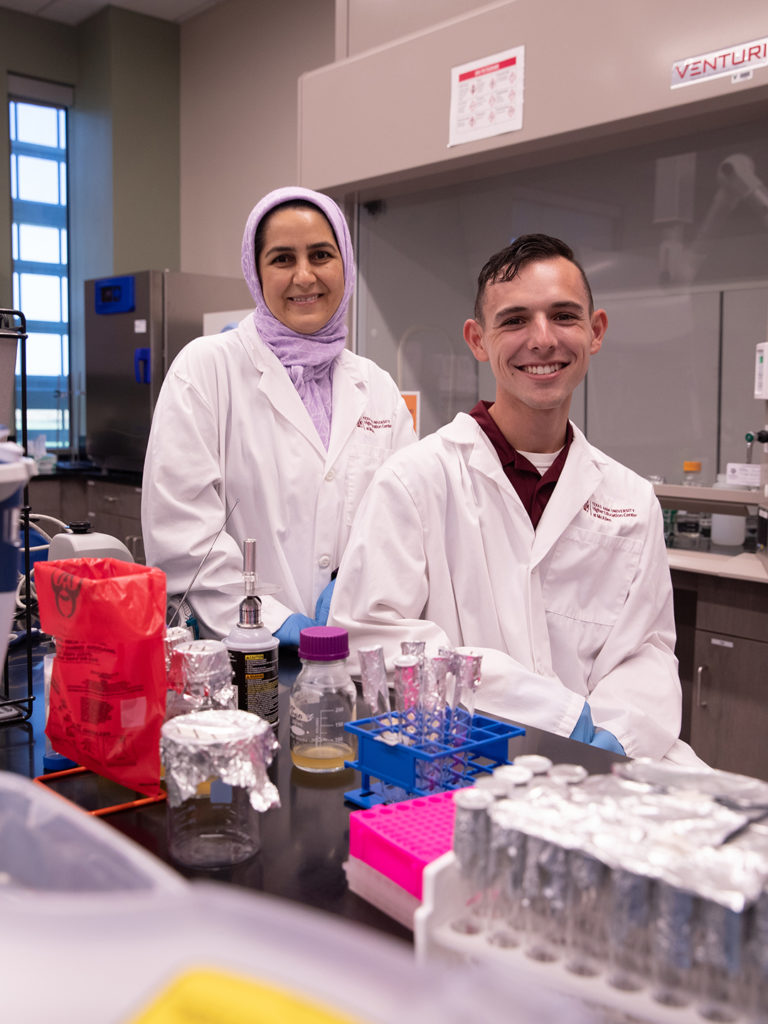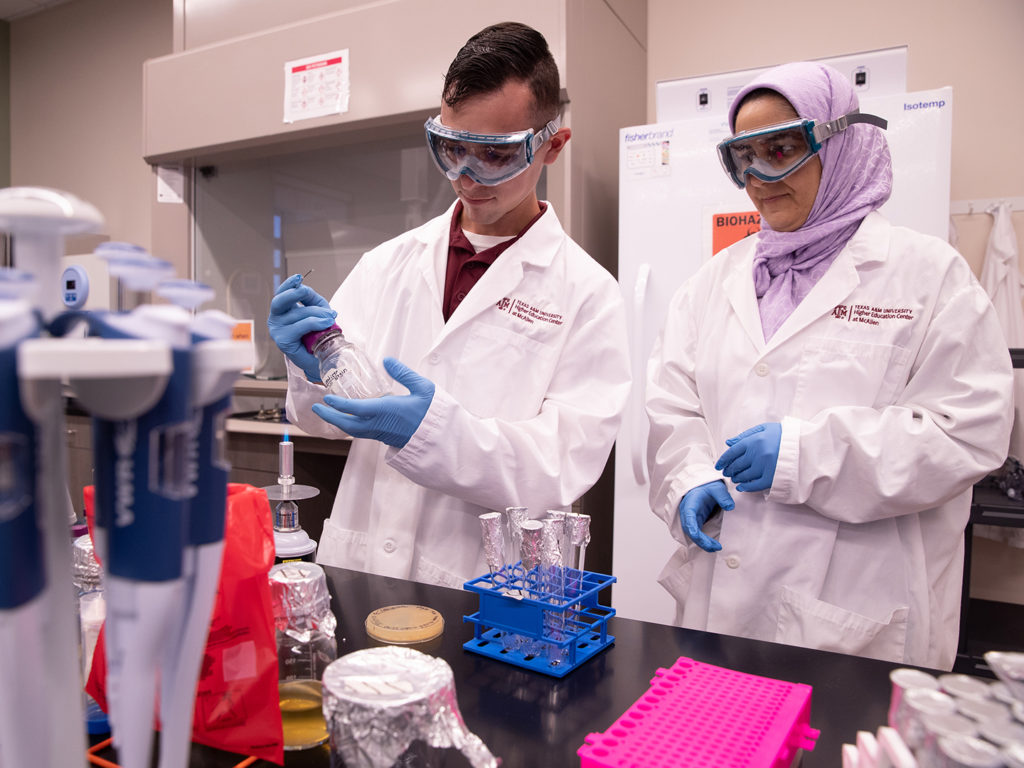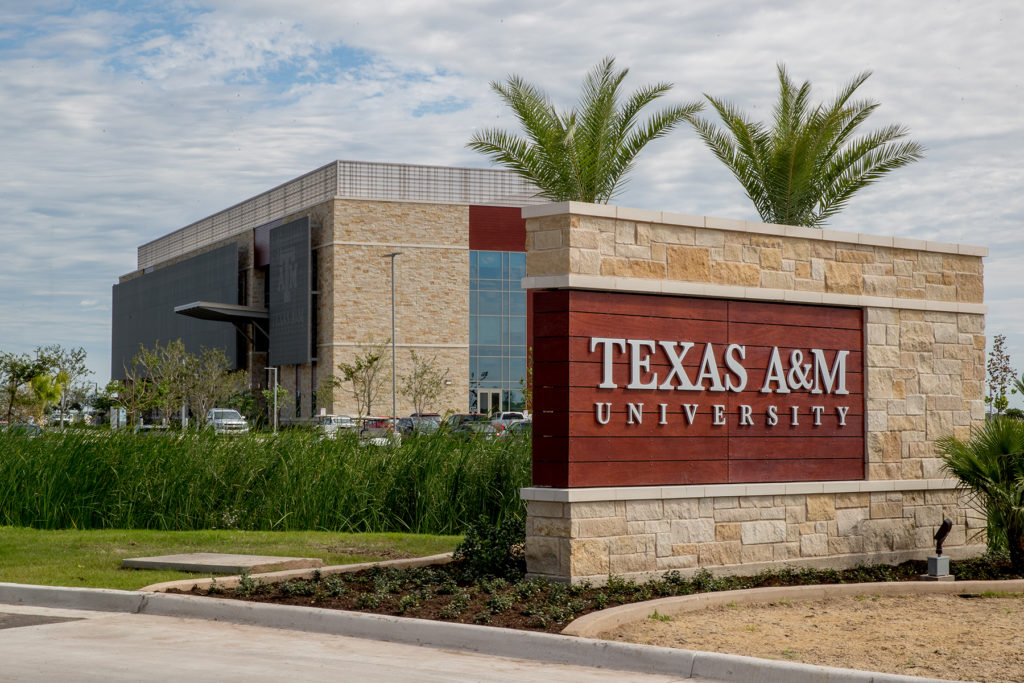Texas A&M Biomedical Sciences Students Launch Research Program In McAllen
Story by Aubrey Bloom, VMBS Communications

Since its inception, one of the key selling points at the Texas A&M Higher Education Center in McAllen has been that students will have the same opportunities they have in College Station.
This also has been true for the School of Veterinary Medicine & Biomedical Sciences’ (VMBS) Biomedical Sciences (BIMS) program at the Higher Education Center.
In addition to ensuring that the VMBS’ BIMS students in McAllen receive the same quality education and live by Texas A&M’s core values, the VMBS has continued to emphasize to BIMS students in McAllen the importance of undergraduate research and the impact their research can have in fulfilling the needs of their community.
This is something well-tested in the VMBS; the BIMS Undergraduate Research Program has grown to be not only the largest of its kind across the country but has been adopted across the Texas A&M campus.
As a result, research has become a crucial part of many students’ undergraduate experience in College Station and, now, in McAllen, according to Dr. Negin Mirhosseini, a BIMS instructional assistant professor at the Higher Education Center.
“It is such a big deal, and often, it’s the students who are pushing for it,” she said. “I receive emails, I get questions during lectures, and I’ve even had prospective students who are considering this campus ask what kind of research we’re doing.
“These days, when many students are looking at a university, it’s something that’s important to them,” Mirhosseini said. “They want to do the science and not just the theoretical part of it. They want to experience how it feels to do actual work and generate actual data.”
A New Program
Research, like anything at the McAllen campus, has had to start from scratch and several obstacles had to be overcome before students could begin.
For example, since Mirhosseini is an instructional professor, she doesn’t have her own active laboratory space, which is a requirement for Texas A&M’s LAUNCH undergraduate research program, so she partnered with faculty in College Station who do have active labs to support her students.
“Student research here doesn’t have to be the same as what the professor in College Station is working on; we just have to have the support of an active lab,” she said. “That was really just the start.”
Between the program just getting off the ground and the limits on in-person instruction because of COVID-19, it was a challenging first year for their research efforts, but Charles Lee, a recent BIMS graduate, said they were still able to have impactful experiences.
“The research community is definitely growing down here in McAllen,” Lee said. “And it’s definitely persevering. Given our circumstances with the pandemic and some logistical challenges with not having access to a lot of high-powered research equipment and labs, it’s been challenging, but our professors have been really good about trying to find ways to engage students with those kinds of experiences.”
Valuable Experience

Even though Lee, a McAllen native, didn’t have a direct connection to Texas A&M, he’s wanted to be an Aggie since he was 9 years old. He heard about the new McAllen campus on the news and ultimately chose it because it allowed him to attend his dream school but still be able to take care of his horses at home.
“Hanging around with all of the 4-H kids growing up and hearing them all talk about A&M, I became excited about A&M early on and never wanted to go anywhere else,” Lee said. “My parents actually made me apply somewhere else just in case it didn’t work out with A&M, but if it would have been up to me, I only would have applied to A&M.”
His research has been related to the COVID-19 pandemic; Mirhosseini challenged her students to design an antiviral for COVID-19, and through reviewing literature and modeling, Lee designed different molecules that could be used for antiviral development.
When the campus was able to host an undergraduate research conference, Lee presented his work and said the whole experience gave him more insight into the pandemic.
“For me, research brings a lot more insight into what you’re studying and what’s really happening,” Lee said. “It’s one thing to learn and just pass the class because you want to, but for me, I have a drive to figure out why things happen the way they do. It really gives me a much deeper understanding of the world. That’s really the big reason why I jumped into doing undergraduate research.”
Even though it’s unlikely that an undergraduate research project will receive funding, or even that the student will continue with it after graduation, research can still have a big impact on students. Lee said just being involved with his project has already possibly changed his career path after he graduates next year.
“Walking into college I was like, ‘I’m just going to medical school; I’m going to be a surgeon,’ and that’s it,” he said. “But interacting with Dr. Mirhosseini and doing a few undergraduate research projects have skewed my thinking from doing just straight medical school to now doing an MD-Ph.D. program. So that’s the ultimate dream goal now. I haven’t decided whether I want to do a blend of surgery and research or just do research solely, but I for sure would like to eventually go on and do research as part of my career.”
Lee said all of that is a credit to Mirhosseini, who actively encourages students to get more involved in research.
“I know how modest Dr. Mirhosseini is, but she’s been the driving factor behind growing these opportunities,” he said. “One of my goals in coming to A&M was to do undergraduate research, but I knew I might be giving that up by coming to the McAllen campus.
“I asked her if she would be interested (in supporting Lee’s desire to conduct research) and she said, ‘Absolutely, we’re going to do this; this is Texas A&M—we can make anything happen,’” Lee said. “She got everything set up, and this year, I’m going to be able to do the thesis program here in McAllen thanks to her.”
Right Place, Right Time

Mirhosseini’s path to McAllen has a few more twists than Lee’s, but the short version is a classic story of being in the right place at the right time.
Originally from Kerman, Iran, where she attended the veterinary college at the University of Kerman as an undergraduate, she attended the VMBS in College Station for her graduate work and received her master’s degree in veterinary microbiology in 2008 and then a Ph.D. in 2011.
Afterward, she moved to the University of Oklahoma, and then to have a more flexible schedule and take care of her new family, she started at Oklahoma City Community College.
Eventually, she moved with her husband to the Rio Grande Valley and was teaching at the University of Texas Rio Grande Valley and South Texas College when, through the now-retired Dr. Susan Payne, she heard that the VMBS was bringing the BIMS program to McAllen.
“It was like ‘oh wow, really, seriously?’” she said. “Dr. Payne told her former colleagues in the BIMS program that she had a former student in the area who would be a good fit if they were looking for a microbiologist. I interviewed for the job, and I got it. It was just really lucky. It was the right time and the right moment to be here.”
Next Steps
Now that they’ve gotten a research program off the ground, Mirhosseini and others at the McAllen campus are trying to figure out how to continue growing the program.
One of their hurdles is simply space—the Higher Education Center has a microbiology lab that can be used for both teaching and research, but that’s just one space.
“We’ve gotten a lot of support,” Mirhosseini said. “Dr. Christopher Quick (Aggie Research Scholars program founder) and Dr. Michael Criscitiello (VMBS associate dean for Research & Graduate Studies) are trying to expand the program, but it’s like renting a house while building a house. We’re starting something and we want to do it successfully so that we can attract more people, more money, and more facilities.”
###
Note: This story originally appeared in the Summer 2022 edition of VMBS Today.
For more information about the Texas A&M College of Veterinary Medicine & Biomedical Sciences, please visit our website at vetmed.tamu.edu or join us on Facebook, Instagram, and Twitter.
Contact Information: Jennifer Gauntt, Director of VMBS Communications, Texas A&M College of Veterinary Medicine & Biomedical Sciences; jgauntt@cvm.tamu.edu; 979-862-4216


